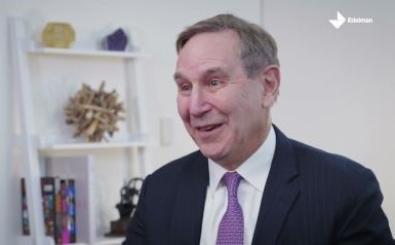How policy people can use an online content strategy to get noticed
The internet is an incredibly noisy place.
Virtually every brand, politician, trade association, NGO and average citizen produces and consumes content across a wide range of digital channels. We're all trying to get our messages to the right people at the right time but fighting the sheer deluge of information online is a serious challenge - especially when you're communicating niche policy issues that don't get a lot of air time.
If you're struggling with this, you are not alone!
The World Bank is one of the most well-known and highly regarded organisations out there and even they struggle. In 2014, they announced that 31% of their policy reports are never downloaded. Not once. And almost 87% of policy reports were never cited1.
In this crowded digital landscape, it's very easy to be ignored.
Recent research by Dr Homero Gil de Zúñiga at the Universidad Europea de Madrid shows that audiences now expect news and opinion to work its way in front of them as they browse the web or use their phones. People no longer feel the need to actively seek out news or public affairs information - known as the 'News Finds Me' perception.
And this is a widespread opinion2: 36% of people in the US feel it; 40% in New Zealand; 50% in South Korea; 50% in Germany; 59% in Italy; 72% in Ukraine and a massive 85% in Spain.
Audiences today are so bombarded by information from millions of different sources that they expect it to reach them wherever they are, whatever platform they're using and at any time of day.
Policy audiences are not different when it comes to this challenge.
People are spending an average of 6 hours 42 minutes online everyday3. The information they're getting can come from anyone. Close family, high-school friends, old co-workers, niche blogs, forums - the list is endless. Not only are those sources potentially crowding you out, they also might be the delivery mechanism for your messaging.
It's a vital point for public affairs professionals to remember: our audiences probably don't get public affairs information directly from a brand, journalist or expert.
Four steps to build your public affairs content marketing strategy

This can seem like an overwhelming problem.
I have a lot of conversations with Brussels public affairs teams who are inclined to completely disengage from online channels because being seen and heard seems far too time intensive.
The good news is we have a methodology that speeds things up and ensures your online content is arriving on time and pushes your target audiences back to you.
Public Affairs Content Marketing: It's a four step process
- Know your campaign goal. It's surprising how often this one gets forgotten. Make sure your campaign is striving to reach something tangible and realistic, all the better if you have a KPI attached to it. The more focused the goal is, the easier it is to design a content strategy that works towards it.
- Choose your audience. Who is vital for reaching this goal? Can you reach them directly or do you need to go via their constituents, staff members or colleagues? Think long and hard about the policy tunnel which starts with the general population and then ladders through the “connected policy community” of NGOs, Think Tanks and key influencers, through into the “direct policy community.” Which of these audiences do you need to engage and at what point with your content to reach your campaign goal? After running a lot of audience analyses, we've found that even the most supposedly niche topics have an audience they can tap into.
- Understand who they are and what they care about. Look at what they talk about, which channels they use, who they follow, which brands they prefer, relevant demographic info - learn your audience inside-out. If you don't understand them you won't be able to create content they want to read, watch and share.
- Match your needs with their needs. Where is the overlap in interest between your campaign goals and what your audience cares about? That's where you focus your content.
If you're like most of our clients, you probably don't have just one audience for your campaign. You'll need to repeat the process above several times and produce a range of content, tailored in tone, format and delivery based on what you've learned about your target audiences.
Even if you have just one audience, that doesn't mean they want the same thing all the time.

This chart showing six different audience needs comes from a very insightful piece of research by the BBC World Service4. Their digital team found that when they focused on one type of content too much, they drove audience engagement down.
This makes a lot of sense. When I go online, I have different reasons. Sometimes I'm trying to find more information, sometimes I want to connect to family and friends, sometimes I'm just a little bored.
If you can get into the head of your reader you'll start seeing those reach and engagement numbers rising.
Test, analyze, iterate, repeat
That first audience analysis isn't going to solve all your issues.
The great thing about digital communications platforms is that everything is live and editable. Every time you post something online, you create data that can help you improve the next post.
There is a wide range of factors that have an impact on how your messages will be received. The same message can be delivered in different forms, using different headlines, fonts and letter sizes, colour-schemes or different calls to action – generating different results. Therefore, testing these variations on a smaller segment of your audience (test audience) before settling for the winner, is a good way forward.

The devil is in the detail and rigorous analysis can help you make the most of it.
There are hundreds of tests you can run but they generally fall under one of four categories: topic, messaging, production and promotion.
If you did the four step process above than your topics should be aligned with your audience already, however you might be able to find a way to talk about your topic in relation to another area - for instance, using the World Cup to talk about how the insurance sector estimates economic value5.
Messaging is likely to be the most fruitful area of testing. That's all about finessing your content to suit your audience and figuring out how to make your point land. Production is where you think about the myriad of formats available online - a blog, a tweet thread, an interactive quiz etc...
Lastly, did you simply promote the content in the wrong way at the wrong time? Use Google Analytics, for example, to figure out when most people are clicking through to your website - that's the best time to post links to your content on social media.
We actually advise spending 20% of your time creating content and 80% promoting it. Stretch that out over 3-6 months and you'll see how content can go much, much further than most organizations push it.
TAKEAWAY: If you want your content to work for you, be obsessed with your audience
Ultimately, this is the key lesson.
Figuring out what your audience wants and delivering that is difficult and time consuming - but worth it.
As public affairs professionals, we can only arrange so many face-to-face meetings in a month. You need to give yourself alternative ways to reach your target audience and a public platform to build support for your point of view.
The modern political landscape is more chaotic and competitive than ever before. Building a public affairs content marketing strategy will set you apart.








